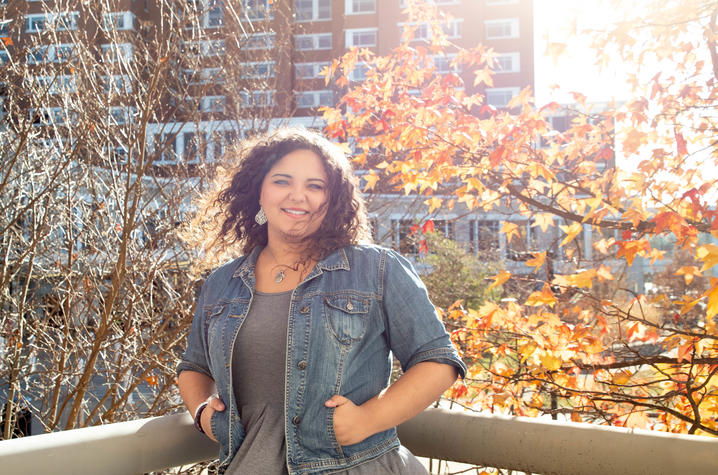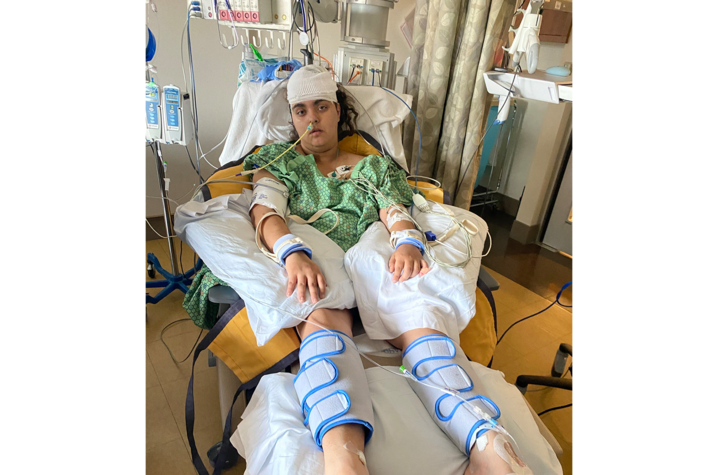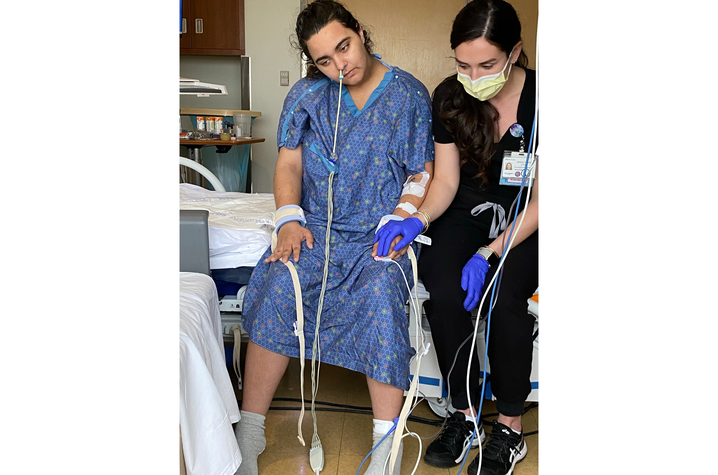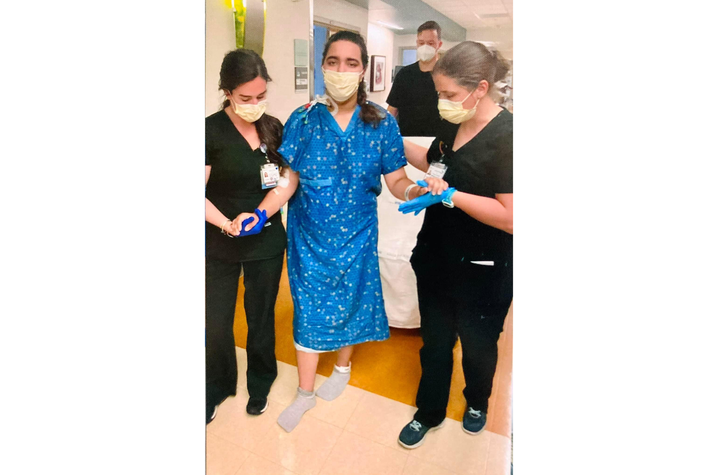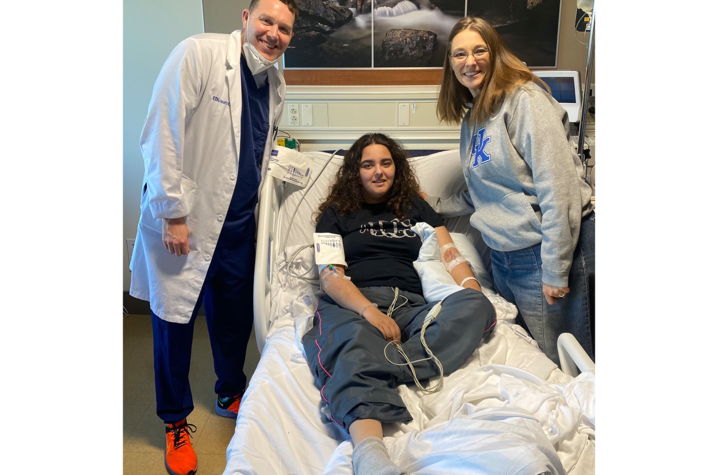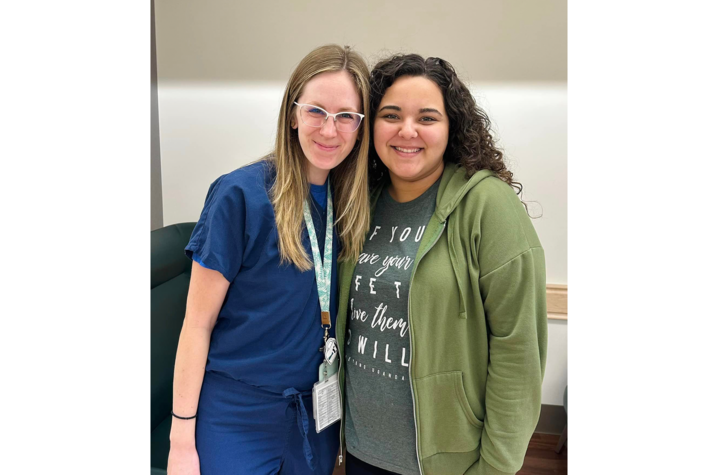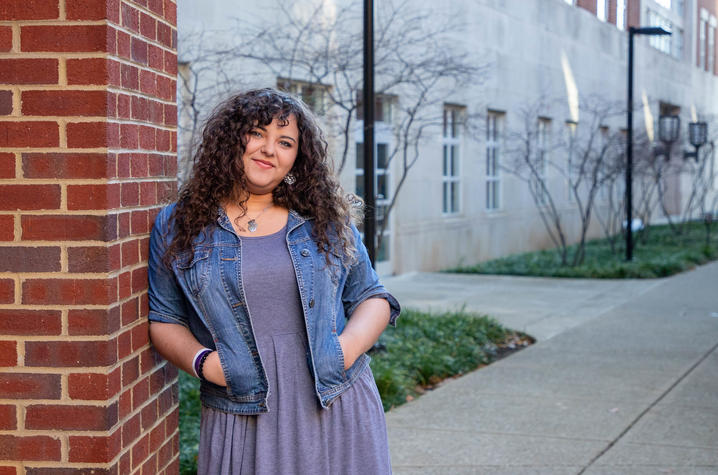A month of madness with a ‘Brain on Fire’: UK HealthCare helps extinguish teen’s rare disorder
LEXINGTON, Ky. (April 16, 2024) — Imagine changing almost overnight and doing things you could not explain. Things like contemplating jumping out of a moving vehicle or aggressively yelling at another person when that is far from your normal temperament.
The estimated one in 1.5 million people who experience this newly identified rare disorder can see changes in behavior and personality, seizures and agitation. This all results from the production of antibodies against the N-methyl-D-aspartate (NMDA) and has become known as anti-NMDA-receptor encephalitis. The syndrome affects primarily young women and evolves over days to weeks. It can present as a psychosis like that seen in schizophrenia.
“She was hallucinating and saying things like, ‘My brain is on fire!’ or, ‘My hair is on fire’,” said Amanda Oliver. “It was hard to get her to realize that this stuff was not real.”
*****
Amanda and Michael Oliver are the proud parents of five children. Their oldest, Allayna, is their only daughter. She’s always been a hard worker and excelled at whatever she set out to do. However, in the spring of 2022, their 19-year-old daughter began hallucinating, having trouble sleeping, erratic behavior and trouble completing basic tasks.
“She turned into somebody that we didn’t know,” said Amanda Oliver.
After looking at their daughter standing in their home with a blank stare and no understanding of what they were saying, they rushed her to their local emergency department.
On the hour-long drive to the hospital from their home in rural Western Kentucky, Amanda remembers being afraid that her daughter might try to jump out of the moving vehicle. “She kept looking at her hands saying, ‘Watch my fingers! Watch my fingers!’”
Once at the hospital, Allayna was placed on a 72-hour behavioral hold. As the hold got close to expiring, the hospital renewed it twice. Since she was over 18 at the time and her family didn’t have medical power of attorney, the Olivers could not be with Allayna or receive any information about their oldest child.
While in the behavioral health unit, Allayna’s condition continued to worsen, leaving the doctors and staff there puzzled. “They eventually told us there were periods where it was like she was catatonic. She would take off running down the hall but then it is like her brain would freeze and she’d just stop. She also would get in the shower with her clothes on.”
After 12 days, a different doctor was rotating in the unit and thought it was extremely strange for a 19-year-old with no previous mental health problems to be there and going through this for more than a week. “He said he had heard about a fairly new disease referred to as ‘Brain on Fire’ and he thought we should do a lumbar puncture to see if that could be what was causing Allayna’s behavior,” remembered Amanda.
The test came back positive for anti-NMDA receptor encephalitis. It is an autoimmune disorder which means that the body creates an immune response to itself.
With this diagnosis, Allayna was moved to a different part of the hospital, and for the first time in 12 days, Amanda could see her daughter. “The first time I got to see her I was shocked. She could no longer talk, she would just sing ‘Hi Mom!’, she couldn’t walk or feed herself. It was so shocking,” remembered Amanda.
Allayna was started on intravenous immunoglobulin (IVIg) and steroids as her doctors updated the family as much as possible while noting they had never treated a patient with this condition and advised that she be transferred to a larger hospital.
Despite health care systems being overwhelmed amid another surge of COVID-19, the Olivers were relieved to hear there was a bed available for Allayna at UK HealthCare’s Albert B. Chandler Hospital. She was transferred and spent her first couple of days in the ICU before being moved to the neurology floor.
“Imagine one day you’re feeling normal, it’s March … then the next thing you know you’re waking up in a hospital in Lexington and they tell you it’s now May? To say I didn’t believe them was an understatement,” said Allayna.
After arriving at UK, Allayna continued her treatment of IVIg and steroids for a few weeks. Both were crucial to minimize the heightened state of her immune system in this disease. She also received plasmapheresis and another round of steroids later on in her admission, again to try and settle down her immune system from trying to attack itself. There was also concern for seizures, so she received close monitoring with treatment for those. Her treatment was also geared to help with her anxiety and agitation so that she could remain calm through it all. Doctors also got her started on Rituximab, which is another immunotherapy for longer-term management so that she would continue on even after leaving the hospital.
“At the time we met, she was only able to communicate in one or two-word responses, and she couldn't convey anything truly meaningful other than that she was scared,” remembers Lauren Bojarski, D.O., a resident in the UK College of Medicine Department of Neurology. “It was heartbreaking for Amanda and me to see the real Allayna trying to come through this brain fog that pervaded her thoughts and caused her so much fear. She just looked... trapped.”
Days passed by and Allayna continued struggling to communicate or even sit up some days. “She would just stare off into space and her body became extremely rigid.”
Everything she was experiencing is typical for patients who develop the rare condition and Bojarski says it all gives a perfect explanation as to why it has been dubbed ‘Brain on Fire’ disease. “Patients experience an abnormal reaction of the body trying to attack its own receptors in the brain. This causes brain inflammation and is described as a ‘brain on fire’. When the brain is ‘on fire’, patients describe being lost in their own mind and body or can even have seizures,” said Bojarski. “Like a fire unable to be controlled, the brain acts without restraint and does things without us being able to control them.”
Now, about two years removed from this experience, Allayna doesn’t remember much from her time in the hospital, especially the first couple of weeks. But there is one thing she remembers about her time in the Kentucky Neuroscience Institute’s Inpatient Unit. “There was this one doctor who always wore bright orange tennis shoes,” said Allayna.
That doctor is Joshua Chalkley, D.O., who was part of the team caring for Allayna and is who she continues her follow-up visits with to this day. While some doctors were hesitant to begin Rituximab, Amanda remembers Chalkley being confident that it would provide the best chance at getting Allayna back to herself.
There was truly a team effort put into Allayna’s care and treatment. She worked with physical therapy, occupational therapy, speech therapy and, eventually, music therapy.
“She wasn’t speaking any more than one or two sentences at a time with our speech therapist, but we all noticed she really enjoyed singing songs from her church back home and was singing multiple full sentences,” explained Bojarski. “We asked our music therapy team to come sing with her, and she really improved regarding her speech and mood after this.”
“She plays the piano at our church. She’s always loved music. She would just come back alive when music was playing,” added Allayna’s mom.
In her last couple of weeks in the hospital, Allayna worked hard to regain strength and coordination to do normal, everyday tasks. Amanda knew one day when getting some fresh air outside and Allayna asked to stand and take some steps that they were finally on the downhill portion of what had been weeks of uncertainty. “It is like we could see her brain starting to really kick back in and our Allayna returning,” said Amanda.
After 31 days at UK HealthCare’s Chandler Hospital, Allayna was able to return home with her parents where her four younger brothers were relieved and overjoyed to have their big sister back.
“Thankfully, God had the right doctors in my path who thought something was not right and ran the necessary tests to get a positive diagnosis. They then advised that I be transferred to a larger hospital because they knew this case was too big for them because of how rare it is,” said Allayna. “And then He had the perfect nurses, doctors and residents in place at UK because putting it simply … they were amazing.”
Her recovery continued once back at home with ongoing therapy. Allayna worked to relearn how to do things like walk and talk. At first, basic tasks were overwhelming. “She would look at her closet as she was getting ready and just cry saying she didn’t know what to do,” remembered Amanda.
It took a few months at home for Allayna to really settle back into her normal life, but she made it. Her family and doctors then shifted their focus to trying to find a cause for this all. What triggered this response from Allayna’s body?
“When we diagnose NMDA encephalitis in a young woman, we know there is a high likelihood of underlying tumor prompting this presentation, and that this is likely an ovarian teratoma,” explained Bojarski. “So even after we had negative studies looking for a mass when she first arrived at UK, we looked again a few months later and found one. We think that her symptoms came before this mass was big enough to show up on any imaging. She had ultrasounds and MRI's done while in the hospital that did not show one.”
Weeks later doctors were able to remove the teratoma, which is a rare type of germ cell tumor that may contain immature or fully formed tissue, including teeth, hair, bone and muscle. Most teratomas are benign (noncancerous) but they can be malignant (cancerous). Allayna’s was benign.
With a rare neurologic condition behind her and the surgical removal of tumor she was unaware of, the now 21-year-old is back to playing the piano at her church and working full-time for Keller Williams Realty.
“It gives me so much happiness to see Allayna thriving in her life now! Whenever Allayna comes to UK for a follow-up, Amanda lets me know so that I can come see her,” said Bojarski. “As I reflect on the pictures we have taken together during this time, I am so proud of how far she has come. From the scared 19-year-old I met in the hospital to the amazing, successful woman she is now. Her mom has done such a fantastic job advocating for her, and Allayna's fighting spirit has really helped her succeed.”
With the incidence rate at one in every 1.5 million, Bojarski says Allayna is truly ‘one in a million’ and that that phrase could not be more accurate. “Getting to help treat Allayna when she needed it most, and to have that continuity over the past few years to see her improve after treatment gives me so much happiness,” said Bojarski. “Her story is one I will never forget for the rest of my career.”
The Oliver family thinks so highly of the care they received from Chalkley, Bojarski and many others at UK, that they make the four-and-a-half-hour drive from their home in far Western Kentucky to Lexington for all of Allayna’s checkups and scans. They plan to continue making the trip as needed and will continue to stop on the neurology floor each time to visit the nurses, therapists and others who they are forever grateful for.
“We are so thankful for God putting the right people in our path. They will never know exactly how much they mean to us,” said Amanda. “We know they don’t always get to see patients from their floor get better and back to normal, so we like to visit and show them their hard work is worth it.”
UK HealthCare is the hospitals and clinics of the University of Kentucky. But it is so much more. It is more than 10,000 dedicated health care professionals committed to providing advanced subspecialty care for the most critically injured and ill patients from the Commonwealth and beyond. It also is the home of the state’s only National Cancer Institute (NCI)-designated Comprehensive Cancer Center, a Level IV Neonatal Intensive Care Unit that cares for the tiniest and sickest newborns and the region’s only Level 1 trauma center.
As an academic research institution, we are continuously pursuing the next generation of cures, treatments, protocols and policies. Our discoveries have the potential to change what’s medically possible within our lifetimes. Our educators and thought leaders are transforming the health care landscape as our six health professions colleges teach the next generation of doctors, nurses, pharmacists and other health care professionals, spreading the highest standards of care. UK HealthCare is the power of advanced medicine committed to creating a healthier Kentucky, now and for generations to come.





